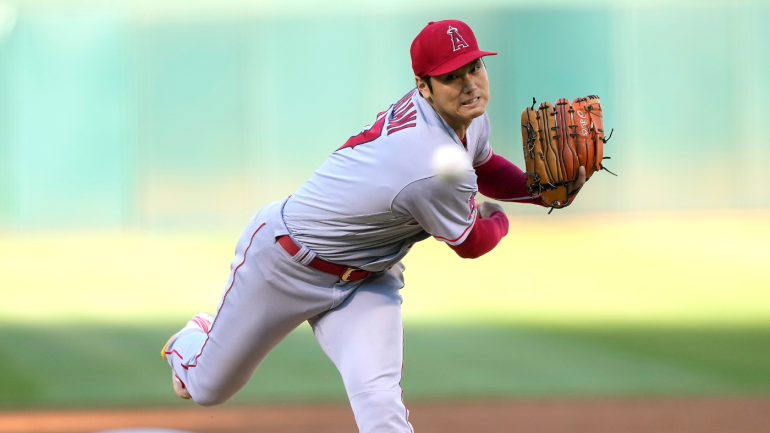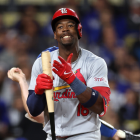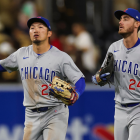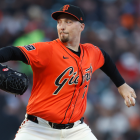
Only seven weeks remain in the 2022 MLB regular season. The trade deadline has passed and dog days of summer have arrived, and soon the postseason races (and the awards races) will really heat up. A dozen teams will play in October this year and there's still plenty of time for the races to get flipped upside-down.
With that in mind, our bi-weekly series breaking down various trends across the league returns Wednesday with a look at the game's greatest talent learning a new trick, one team's offensive futility, and the league-wide shutout pace. Last time we looked at the Rays botching the little things, Chad Kuhl's adjustments with the Rockies, and the Yankees chasing home run history.
Ohtani's new pitch
Two things are true: Shohei Ohtani is not having as good a season in 2022 as he did in 2021, and Ohtani is having an incredible 2022 season. He is on pace for 8.1 WAR, a tick below last year's AL MVP-winning 9.0 WAR mark, thought the shape of his production has changed. Pitcher Ohtani has surpassed Hitter Ohtani. The quick comparison:
| Pitcher Ohtani | IP | ERA+ | Equivalent |
|---|---|---|---|
2021 | 130 1/3 | 141 | Framber Valdez (137 ERA+ in 134 2/3 IP) |
2022 | 117 | 149 | Zack Wheeler (141 ERA+ in 132 2/3 IP) |
| Hitter Ohtani | PA | OPS+ | Equivalent |
2021 | 639 | 157 | Aaron Judge (149 OPS+ in 663 PA) |
2022 | 482 | 137 | Mookie Betts (137 OPS+ in 449 PA) |
Pitcher Ohtani unveiled a new toy Monday night, when he held the Mariners to two runs in six innings while striking out eight. He used a sinking two-seam fastball for the first time in his career. Ohtani told reporters, including The Athletic, he has been working on the pitch in bullpen sessions, and finally decided to take it into games.
Ohtani only threw the sinker six times Monday, but it averaged 97.3 mph and topped out at 98.1 mph, and the movement was quite a bit above average for high-velocity sinkers. The results on the pitching weren't great -- the six sinkers went for four balls, one swing and miss, and one ground out -- though the velocity and movement give the pitch promise.
Ohtani is a true five-pitch pitcher who throw all five pitches to both righties and lefties. He throws an upper-90s four-seam fastball, a splitter, a slider, a curveball, and a cutter. Now this new sinker gives him a sixth pitch. It's fair to wonder whether six pitches is too many -- why get beat on your fifth- or sixth-best pitch? -- but with the Angels already out of the race, there's no harm in trying it.
Elevated four-seam fastballs have been all the rage the last few seasons. Pitching north-south was -- and still is -- very effective, though everything in this game is cyclical. Teams are starting to gravitate back toward sinker and sliders (sweepers, really) and a more east-west attack. Ohtani has mastered the north-south approach. The sinker can help him master east-west too.
I don't think there's a more talented player in the world right now than Ohtani. Performing as well as he has on both sides of the ball has never been done before, and it takes a unique level of skill and aptitude. I fully expect him to master the sinker and turn it into a viable weapon. It might not happen right away, learning a new pitch is hard, but he wouldn't have taken it into a game if he wasn't serious about incorporating it into his arsenal. As good as he is, the new sinker shows Ohtani is still working to get better.
Marlins narrowly avoid record for offensive futility
Safe to say this season has not gone according to plan for the Marlins. The club invested heavily (by their standards, anyway) in its position player core this past offseason, and the result is one of the lowest-scoring offenses in baseball. The Marlins went into Tuesday's action averaging only 3.73 runs per game. Only the Tigers (3.19), Athletics (3.34), and Pirates (3.61) have been worse.
Tuesday night's win over the Padres (MIA 4, SD 3) ended a 16-game streak in which the Marlins scored no more than three runs. Even with the four-run outburst Tuesday, they're averaging 2.00 runs per game in their last 17 games, and in their last 30 games, they've scored more than three runs only five times. Miami recently tied a franchise record with a 37-inning scoreless streak. That's more than four nine-inning games.
The 16 straight games with no more than three runs scored is tied for the seventh longest streak in a single season in history. Here are the top six:
- 1942 Cleveland: 19 straight games with three or fewer runs (Aug. 9-26)
- 1908 Dodgers: 17 (May 24 to June 13)
- 1908 Yankees: 17 (Sept. 20 to Oct. 7)
- 1915 Yankees: 17 (Sept. 8-22)
- 1919 Dodgers: 17 (Aug. 7-21)
- 1969 Angels: 17 (May 9-27)
It should be noted the Dodgers had a 19-game streak with no more than three runs scored spanning the end of 1906 and start of 1907, but we're only looking at single-season streaks here. By scoring four runs Tuesday, the Marlins narrowly avoided doing something that hasn't been done in more than half a century. The top spot on that list was only a few days away.
What's gone wrong for the Marlins this year? Well, a lot. For starters, their offseason pickups have all been busts. Not a single one is working out anywhere close to as hoped. Look at these numbers:
| PA | AVG/OBP/SLG | OPS+ | WAR | Cost to acquire | |
|---|---|---|---|---|---|
342 | .232/.269/.322 | 67 | -0.8 | 4 years, $53 million | |
OF Jorge Soler | 306 | .207/.295/.400 | 95 | 0.4 | 3 years, $36 million |
288 | .221/.286/.290 | 64 | -0.7 | ||
IF Joey Wendle | 250 | .259/.300/.349 | 84 | 1.5 |
There have been some injuries along the way (García and Soler are on the injured list right now and Wendle missed a chunk of the first half with hamstring trouble) and Wendle's defense has been above average, but gosh, that is way too many empty plate appearances. The single biggest reason the Marlins are mired in this miserable offensive slump is their offseason additions going belly up. To a man, they've fallen well short of expectations.
Also, several incumbent players have taken steps back. Jesús Aguilar is having his worst full big-league season (.238/.288/.397). Miguel Rojas is too (.238/.289/.339). Youngsters Jesús Sánchez (.205/.271/.387) and Bryan De La Cruz (.205/.249/.332) played their way back to Triple-A. Jazz Chisholm Jr. being limited to 60 games by a back injury hasn't helped matters, but this Miami team is not one healthy Chisholm away from being even an average offensive club.
The Marlins are seventh in the league in fewest runs allowed per game and they have the NL Cy Young favorite in Sandy Alcantara. The pitching is there, for most part. The offense though? It's far from being postseason contender caliber, and it won't be an easy fix. They're tied to their offseason pickups for multiple years and getting position player prospects to take the next step has been a challenge. The offense is something GM Kim Ng and her staff must figure out after the season.
Shutouts up league-wide
No, not individual shutouts. Those are still trending down. There have been only six nine-inning complete game shutouts this year (Hunter Greene had a rain-shortened seven-inning shutout) and, barring a sudden spike in shutouts these last few weeks, MLB will set a new record low for complete game shutouts this year. The leaderboard (ignoring the pandemic shortened 2020 season):
- 2022: 6 nine-inning complete-game shutouts (on pace for 9)
- 2018: 18
- 2021: 24
- 2019: 25
- 2017: 28
Pitchers are being used less and less these days and complete games are damn near going extinct, so it is no surprise the last five 162-game seasons are the five seasons with the fewest complete game shutouts. There is a very real chance MLB does not get to 10 nine-inning complete game shutouts this year. The decline in shutouts in precipitous.
Complete game shutouts are becoming exceedingly rare. Team shutouts are alive and well, however. In fact, it's been a long time since they've happened this frequently. Going into Tuesday's action there were 246 team shutouts in 1,734 total games this year. That's 14.19 percent of all games and one shutout every 7.05 games, or roughly two a night.
The team shutout rate has hovered in the 9 percent to 11 percent range since the turn of the century, with a few scattered 12s and 13s. Last year it was 12.31 percent and in 2019 it was 11.03 percent. Even in the bizarre 2020 season, the team shutout rate was a decidedly normal 11.14 percent. Here are the last five seasons with team shutout rates as high as 2022:
| Percent of games | Games per shutout | |
|---|---|---|
2014 | 14.53% | 6.88 |
1992 | 14.15% | 7.07 |
1981 | 15.78% | 6.34 |
1978 | 14.51% | 6.89 |
1976 | 16.76% | 5.97 |
Teams averaged 4.07 runs per game in 2014 and the league hit .251/.314/.386 overall. It was the worst offensive season in more than two decades and, given the rise in home run rates in subsequent years, maybe it spooked MLB into manufacturing a livelier baseball. I dunno. I do know this year's team shutout rate is roughly the same as 2014, when offense was way down.
I do think there's some correlation between the rise in team shutouts and the decline in individual shutouts. Teams are all about optimizing pitching matchup these days. They don't let starters go through the lineup a third time and bullpen roles are less rigid, with matchups dictating usage more than, say, the inning. All of that is intended to stifle the opposing offense. Do that and it equals fewer complete games, but also more effective pitching as a team, and thus more shutouts.
Complete games are neat and complete game shutouts are a lot of fun. There's nothing quite like pulling for your guy to go the distance and beat the other team himself. Team shutouts? Eh. They're cool when your favorite team is doing it, otherwise they can be kinda blah. Fairly or unfairly, they're games that tend to get chalked up to poor hitting more than great pitching.
It's entirely possible this year's team shutout rate is an anomaly -- the years around 2014 didn't have team shutout rates nearly as high -- but it is happening. Teams are being shut out more often this season than at any point in the last eight years, and at a rate that has been approached only once in the last 30 years. Complete games are down, but there are shutouts aplenty.


























